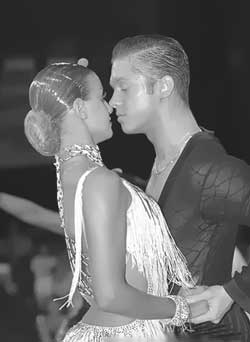
| HOME | MENU | DOCS | SEARCH |
see Recommended reading in dance. Symbols and abbreviations
Hispanic couple dance of Cuban origin, part of an international program of sporting ballroom dances, different characteristic sensual, full of love movements. Muses. 4/4, the rate of 28-30 m / min. (112-120 beats / min).

The name 'Rumba' possibly comes from the term «rumboso orquestra», as in Cuba called musicians performing dance tunes. The dance originated from the Cuban habanera with Spanish roots and African rhythms brought to Cuba at the end of the XIX century. The forerunners of today's Cuban rumba were slow dancing «son» and «danzon», their versions were known in the United States in the 1930s.
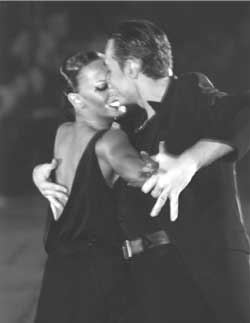
In Europe, rumba appeared thanks to Pierre Lavelle, tantsshkoly teacher in London, who has developed on the basis of national (Havana) Cuban rumba dance standard. He visited Havana in 1947, and it turned out that the rumba in Cuba is done with an emphasis on the expense of "two" rather than "one", as the US. This technique, he began to teach in England, many speakers, and after much debate, in 1955, the rumba was officially recognized and standardized.
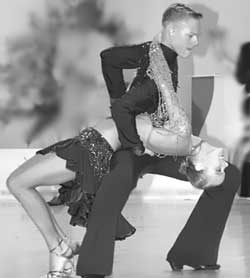
With the new version - only weight transfer to the account of "time", without actually step dance acquired his famous sensual and voluptuous. The first beat of the music rumba is the strongest, but at this point only move the hips. Together with the slow pace of the music and the musical emphasis on hip dance work gets lyrical and erotic nature. Steps are being made at the expense of 2, 3 and 4.
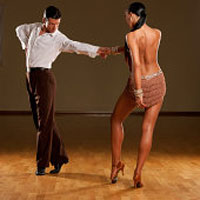
Cuban in origin, the Rumba, depending on the pace has other names: in a slow tempo, Bolero, quick — guaracha. Size: 4/4.
Temp: 32 bar 128 BPM.
Basic rhythm: quick, quick, slow. Every "fast" corresponds to one share, and "slow" or two, with accent on the first and third beats of the bar. Position: both partners are somewhat distant from each other, the body is straight. Right hand partner lies on the left shoulder of the partner, the arm nearly extended. The left hand slightly higher than usual, the left forearm almost vertically. Shoulders and upper body remain absolutely motionless during the entire dance. Only the typical movement of the knee causes a slight swaying of the hips. All steps are performed with the pads of the feet.
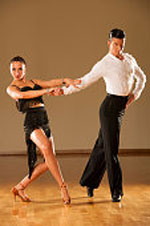
1. Progressive move forward (step promotion)
Starting position: feet together, face the line of dance or facing the wall.
For the Partner:
1. A small step right foot to the right (fast).
2. To fasten the left leg to the right (fast).
3. To bring forward the right leg, shifting her body weight (slowly).
4. A small step left foot to left (quick).
5. Pristavit right foot to the left (quickly).
6. To bring forward the left leg, shifting her body weight (slowly).
Repeat with # 1.
For the Lady:
Takes the opposite steps. During the performance of p. 3 and p. 6 show the typical movement of the knee of the leg that is not moved the center of gravity. The knees are connected without the convergence of the feet, which causes a pronounced swinging of the hips. Recall that this requires flexibility of the ankles, knees and hips.
A progressive course from the partner often turns ago, through the dance, all the steps 1-6 p. — in the same rhythm (quick, quick, slow), and partner — forward line of dance.
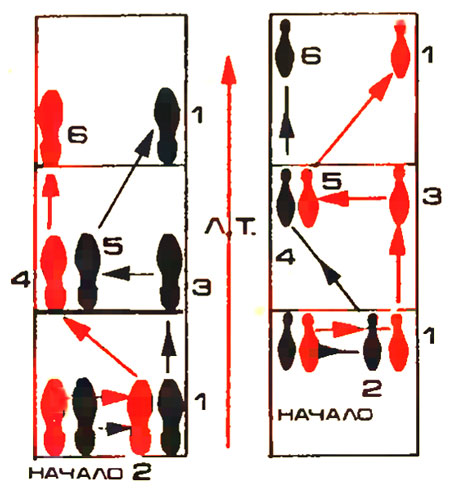
Fig. A progressive step of Rumba
2. Natural square
Movement perform on the spot. It is possible to start both the right and left foot, using to rotate the seat right or left.
For the Partner:
Starting position: feet together at the line of dance or facing the wall after a progressive move forward with the left foot (see above). Ends face the line of dance.
1. A small step right foot to the right (fast).
2. To fasten the left leg to the right (fast).
3. To bring forward the right leg, shifting her body weight (slowly).
4. A small step with the left foot to the left at the level of the right foot (quick).
5. Pristavit right foot to the left (quickly).
6. To bring the left foot back, shifting her body weight (slowly).
Repeat with # 1.
For the Lady:
Takes the opposite steps.
This movement can be repeated indefinitely. To rotate, increment the angle in the desired direction.
Inverse square marks as well as natural square described above, but p. all steps 1-6 with the other foot.
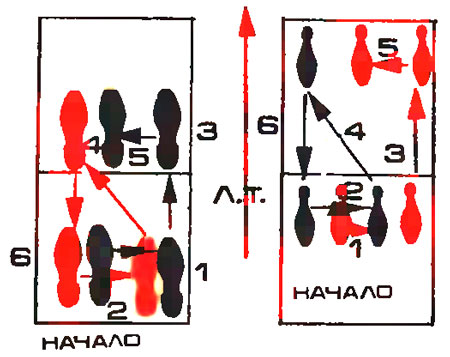
Fig. Natural square
Currently popular three styles of Rumba.
1. Rumba square. The most simply constructed, easily grasp the rhythm, she quickly perceived the dancing.
2. Rumba Bolero. Similar to the previous Rumba, but turns to the rhythm of slow. All variations of the Rumba, indeed, can be executed more slowly. Most of the modern tunes that innocent ear perceives as slow, in fact, built into the rhythm of the Rumba, the Bolero. If you carefully listen to the accompaniment, then determine that it meets the following rhythm: slow, quick, quick, with the accent on the second and fourth beats of the bar.
3. The Cuban Rumba. Standardized by the British, it is the only option executable at the event. Cuban Rumba requires a good sense of rhythm, and also a perseverance to mastering the small technical and elusive in the beginning of the subtleties that arise from knowledge of the equilibrium and gorgeous coordinated work of the ankles, knees and hips. Constant training gives the dance of lightness that distinguishes the pair, dancing in unison. The rhythm of the Cuban Rumba has undergone some changes.
Basic rhythm: quick, quick, slow ("two", "three", "four", "times").
Position: partners are from each other at a short distance, the partner puts his right hand on the left shoulder blade of your partner at the same time, her left hand lies on your shoulder partner.
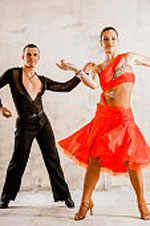
1. The Cuban greeting, twisting and untwisting (Square Rumba and Rumba Bolero)
This movement can be performed in various ways. The most common is that it is performed after the first part of the squared "time":"", "two", "three" — quick, quick, slow; right, left, right foot to partner.
Body above the waist should be kept straight, the shoulders are at the same level. The slopes in Rumba no. All steps are performed with the pads of feet on all foot. The steps are small. The hips should be soft, not exaggerated .
For the Partner:
The Cuban greeting
1. Step left foot forward (fast).
2. Step right foot to side right (fast).
3. Step left foot back (slow).
Tightening
1. Step right foot forward towards partner, but with a right turn (fast).
2. Step left foot forward; continuing turn to the right, the lady is spinning in the hands of a partner (quickly).
3. Step right foot forward, spinning so took the left hand right hand partner, "twisted" on the right hand (slow).
4. Step left foot forward, turning clockwise; the partner releases the waist of the female partner and take the right palm of her left hand (fast).
5. Step right foot forward, continuing turn (quickly).
6. Step left foot forward, continuing turn and passing half circle (slow).
7. Step right foot forward, turning in the same direction (fast).
8. Step left foot forward, continuing turn (quickly).
9. Step right foot forward, finishing the turn and coming full circle (slow).
Unwinding
1. Step left foot forward, bringing your partner to the right (fast).
2. Step right foot to side right (fast).
3. Step left foot back (slow).
Repeat the tightening and loosening as desired.
For the Lady:
The Cuban greeting
1. Step the right leg back (quickly).
2. Step left foot to side left (quick).
3. Step right foot back (slowly).
The partner takes the right brush the left hand of the partner. Partner plays the greeting: raises right hand at eye level and looks right, like sends greetings.
Tightening
1. Step left foot forward (fast).
2. Step right foot to side, turning left against the line of dance (quick).
3. Step left foot back (slow).
Partner is close with a partner, "twisted" his right hand, which he wraps around her waist. In this position she takes the steps like the "gyroscope":
4. Step the right leg back, turning on the spot clockwise (fast).
5. Step the left leg back, continuing the turn (quickly).
6. Step the right leg back, continuing the turn and passing half circle (slow).
7. Step the left leg back, turning in the same direction (fast).
8. Step the right leg back, continuing the turn (quickly).
9. Step the left leg back, finishing the turn and coming full circle (slow).
Unwinding
1. Step right foot to the side with a right turn from a partner (quickly).
2. Step the left leg back turning to face partner (quickly).
3. Step right foot back (slowly).
Repeat the tightening and loosening as desired.
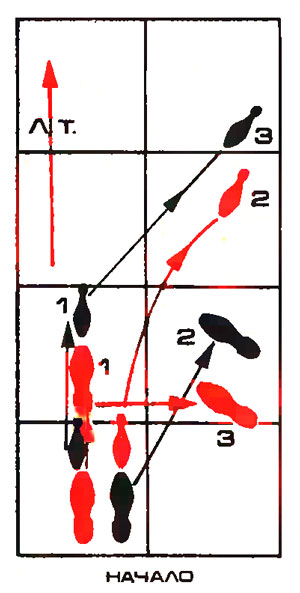
Fig. The Cuban greeting. PA partner and partner
Note: At the end of this figure the partner and the partner are in the opposite direction of the original; however, depending on the length of the steps performed on the corners, it can vary. From the figure, note the direction of the housing relative to the audience.
2. The top (Square Rumba and Rumba Bolero)
Here we present a series of pretty movements, demanding for the execution of the little space. This series is very impressive and like mates, even inexperienced. Consider a simple but beautiful top. It is performed in the promenade, for example, after a push by Brazil (see below). The position of the promenade on three parts of the bar: "one", "two" — the main motion, three — partner puts a foot forward diagonally towards the partner (her waist he puts his arm), to be in the position of the promenade diagonally to the center.
The partner can then go to the " top " ago, performing the steps of the Cuban March, i.e. stepping back in the rhythm of the Rumba (quick, quick, slow) — two steps are the same, and the third is stretched.
For the Partner:
1. Step the left leg back behind right leg with left turn (quickly).
2. Step right foot to side turning to the left (quickly).
3. Step the left leg back with left, as in claim 1, is stretched and the pitch (slowly).
4. Step right foot to the side with a left turn as in section 2 (fast).
5. Step the left leg back with left turn as in section 1 (fast).
6. Step right foot to side, like in step 2 — step stretching (slowly).
7. 8. 9. Correspond to 1, 2, 3, while the partner removes his right hand from the waist of your partner and getting in front of her, as in the main motion. Now he can play the square, starting with the right foot (quick, quick, slow).
For the Lady:
Performs the opposite steps, following the partner flexibly and synchronously. The movement of the hips in variations of "the top" are absent.
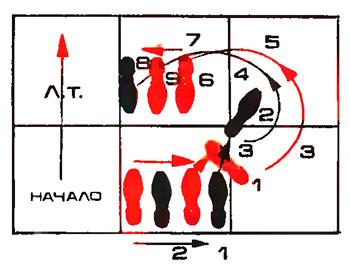
Fig. Top. PA partner: 1-9 — concentric rotational movement of the foot and return to starting position
3. Push the foot in Brazilian (Square Rumba and Rumba Bolero)
This is a fun variation breaks the basic rhythm of Rumba. She danced to the rhythm quick, quick, slow, "and" (or "one", "two", "three", "four", "I").
"And" — couple in promenade position (with opposite leg) makes a push that marks a slight slipping of the sock on the floor, as if you need to slightly shift some weight.
For the Partner:
1. Step right foot to side right (account "raz").
2. Pull left foot to right ("two").
3. Step right foot diagonally forward and right to the partner, hug her waist with the right hand; the pair in positions a boardwalk ("three", "four").
4. Push left foot-Brazilian ("and").
5. Step left foot forward, shifting her body weight; the position of the promenade diagonally to the center ("one").
6. Cross right foot behind the left in the same position ("two").
7. Step left foot side left turning on the diagonal to the wall ("three", "four").
8. Push the right leg in Brazilian ("and").
Repeat as desired.
To return to the original position when the push with the right foot (step 8), do not perform it the last time and become a line dance, thereby indicating to the partner that she should not cross your legs. However, you can allow her to do this push, my partner in this time will have the opportunity to show her the change of direction, following the line of dance.
For the Lady:
During the first three lobes of the stroke becomes the position of the promenade.
1. Step left foot to side left (account "raz").
2. Pull the right foot to the left ("two").
3. Step left foot left, slightly to the partner, who puts his arm around her waist, touching the thighs ("three", "four").
4. Push your right foot diagonally to the center ("and").
5. Step right foot forward, transferring her weight, turning its back diagonally to the wall ("one").
6. Cross left leg in front right in the same direction (two).
7. Step right foot to side right with the change of direction, back diagonally to the center ("three", "four").
8. Push left foot diagonally to the wall ("and").
Continue as desired. If the partner moves on to the basic movement, the lady takes the opposite steps.
Note: in Order to achieve success in this beautiful figure, the pair may at the time of execution of the push leg to make the easy and flexible movement of the knee of the supporting leg, which makes it pas more graceful. Should not take the foot off the floor and perform a push with the heel, except in the case when you need to make a motion comic.
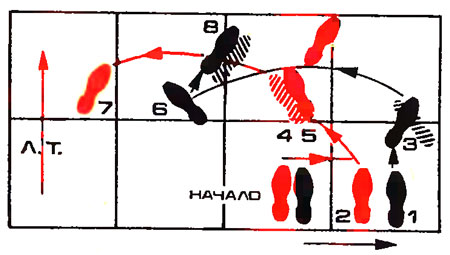
Fig. Push the foot in Brazilian
4. The main motion (Cuban Rumba)
The movement is very beautiful if executed flexible dancers, good sense of rhythm. However, we still advise to do his debutants and other dancers, as it helps elegantly to link shapes.
For the Partner:
1. A small step left foot forward, first on the front of the foot, then whole foot ("two").
2. To transfer body weight to right foot back, on the spot ("three").
3. A small step left foot to left side, drawing on it to fix (account "four", "times").
4. A small step the right leg back ("two").
5. To transfer body weight to the left foot forward (count to three).
6. A small step right foot to right side, relying on her to fix (account "four", "times").
For the Lady:
Performs the opposite steps: p. 1-3 p. 4-6 correspond to the partner; p. 4-6 p. 1-3 partner.
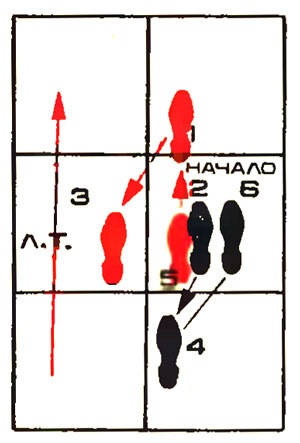
Fig. The basic movement Rumba. PA partner. Partner performs the opposite steps; 1, 5 — movement on the spot where the steps are fixed without displacement of the feet
5. Natural top (Cuban Rumba)
This figure of 12 cycles is executed with a right turn. It is nearly identical to the top square Rumba, you only need to adapt it to the rhythm of the Cuban Rumba.
In this figure partners are facing each other. Turn to the right turns clockwise around its axis, no promotion.
For the Partner:
P. takes 1-3 basic movement, but the third step is to the side and slightly back ("two", "three", "four", "times").
Then continues as follows:
1. Turn right, cross right foot behind left (toe turned out), put the toe of the right foot near the left heel ("two").
2. Continuing right turn, step left foot side left and slightly forward (toe turned inward) — three.
3. Repeat step 1 (through "four", "times").
4. Repeat step 2 ("two").
5. Repeat step 1 ("three").
6. Repeat step 2 (count "four", "times").
7. Repeat step 1 ("two").
8. Repeat step 2 ("three").
9. Pristavit right foot to the left (count "four", "times").
For the Lady:
P. takes 1-3 basic movement, but the third step is to the side and slightly forward ("two" "three" "four" "times"). Then continues as follows: 1. Turn right, step left foot to side and slightly forward (toe turned in) — two.
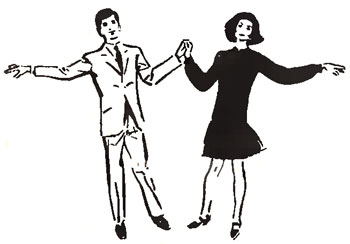
Fig. Open position — fan
2. Continuing to turn right, do a slight twist on the toe of the left foot and cross right foot in front of left toe; the heel of the right foot before the left toe and the left toe is turned out ("three"). 3. 4. 5. 6. 7. 8. To alternately repeat 1. and 2. (count "four" "one" "two" "three" "four" "one" "two" "three"). 9. Continuing turn left, step left foot left (count "four", "times").
6. The fan (Cuban Rumba)
We are talking about are graceful and easy to figure, during which the partner needs to monitor closely the performance of its movements, and a partner for a sign at the time of removal and return of the partner. The fan position — the standard position for Rumba and cha-cha-cha.
For the Partner:
Begins to move in the normal position, finishes in the open. Partner is left from the partner. The fan is usually preceded by paragraph 1-3 of the main motion. Then continues as follows:
1. Step the right leg back, taking your partner, which goes a step further to the partner ("two").
2. To transfer body weight to the left foot forward and lead partner, which turns to the left; right hand to let go ("three").
3. A small step right foot to the right, continuing to partner with the left hand, lowering it to the waist of the female partner (the expense of "four", "times").
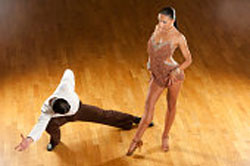
In the position of "fan" is to the left partner partner almost outstretched his left hand; its body is at a right angle relative to the body of the partner and about 15 cm in front.
For the Lady:
1. Step left foot forward, first on the ball of the foot, then whole foot; movement in line with the partner ("two").
2. Turning to the left, step the right leg back and slightly to the right; left hand to let go ("three").
3. Continuing turn left, step left foot back; at the end of the movement to weaken the heel of the right foot (count "four", "times").
Note: There are other more complex ways to "fans". Described is most applicable. Usually the movement of the "fan" associated with other variations Alemana or hockey stick (see below).
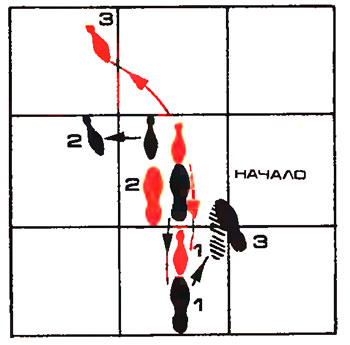
Fig. Fan. PA partner and partner
7. Alemán (Cuban Rumba)
This figure marks after fans with which it blends well.
For the Partner:
1. Step left foot forward, leading your partner, which puts the right foot to the left ("two").
2. To transfer weight back on right foot, leading partner forward ("three").
3. To fasten the left leg to the right, leading partner forward with his left hand and starting to turn it to the right (count "four", "times").
4. Step the right leg back, taking your partner, which continues to rotate to the right under raised left hand (two).
5. To transfer body weight to the left foot (in place), leading partner, which continues to rotate to the right ("three").
6. Pristavit right foot to the left, allowing the partner to finish rotating to the right and take again the closed position (account "four", "times").
Partner in the figure of rotation no.
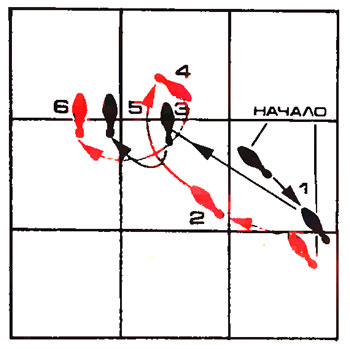
Fig. Alemán. PA For the Lady
Note: it Should be noted that the steps of the Alemanni are the same as in the basic movement, so you should pay special attention to "play" the hands.
For the Lady:
1. Fasten right leg to the left in the position of "fan" (two).
2. Step left foot forward towards partner ("three").
3. Step right foot forward to face partner, starting in front of him turn right under raised right hand (the fourth count, "times").
4. Step left foot forward, turning to the right ("two").
5. Step right foot forward, continuing turn ("three").
6. Step left foot forward and to the side, finishing turn to face partner (the expense of "four", "times").
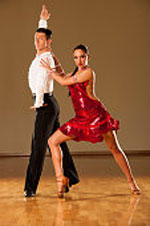
Chords and variations
A. Square Rumba and Rumba Bolero
1. Consisting of 8 cycles:
Step with promotion — square — step promotion — a square with a half-twist to the right. To repeat in a new direction.
Square — three first steps with the promotion of Cuban greeting — twisting — untwisting — 3 steps back. Repeat.
Square — disclosure in the promenade — top — square. Repeat.
2. Consisting of 16 bars:
Square — opening in the promenade, push the foot in Brazilian (2 times) — to finish right in the boardwalk— top — finish the basic movement and Cuban greeting — twisting — untwisting (optional) -3 step back. Repeat.
B. Cuban Rumba
1. Consisting of 4 cycles:
Basic movement fan Alemana. Repeat.
2. Consisting of 8 cycles:
The basic movement — fan — Alemana — natural top — base movement (2nd half). Repeat.
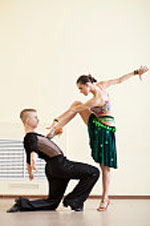
<< Back: Latin ballroom dance program
Maria Vasilevskaya "Dances from A to Z" book about dance for a wide range of readers
We recommend that you look at the popular sections of the site myvaleology.com: MENU with a description of the sections | |||
| SOCIAL | DONATION | MY DIET | MY SPORT |

|
Release all4e8 |
||
Copyright © VZOJ 2023. All rights reserved. When reprinting or quoting myvaleology.com materials please put a link to the site myvaleology.com :
<a href="https://myvaleology.com">Healthy lifestyle</a>